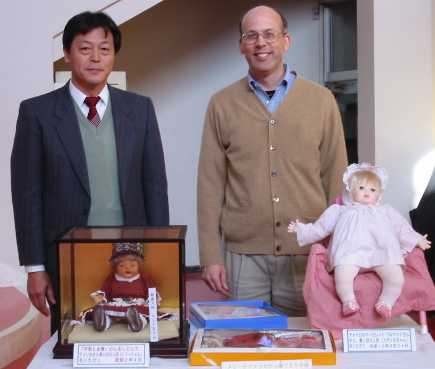|
|

|
|
With Vice Principal
and School's Two Dolls
|

|
|
|
I went to talk with the enthusiastic first and
second graders after a quick lunch with the sixth-grade students. I began
with a presentation about the Friendship Dolls and the United States. When I
asked whether the children had any questions, I was amazed when over half of
them raised their hands, eager to ask questions. The children had so many
questions that time ran out before I could answer all of them.
The children had many interesting questions,
including several about the Friendship Dolls exchanged between America and
Japan in 1927. When they found out that their school's doll is 74 years old,
they seemed to think I was quite young at 44. One boy asked why the dolls
have blue eyes, and the students were surprised to look at my eyes and see a
blue color. I explained that although many Americans have blue eyes, the
United States has many different kinds of people living together with
different eye colors. Also, several of the "Blue-eyed Dolls" had
eyes other than blue.
Two or three students had detailed questions
about the Blue-eyed Dolls that I could not answer, so Ms. Shizukuishi, an
active member of the Miyagi Blue-eyed Doll Study Group, kindly helped me by
answering them. She answered questions about the sizes of the Blue-eyed
Dolls, the existence of boy dolls, and the dolls in Miyagi Prefecture. After
finding out that there were some boy Blue-eyed Dolls, we had some discussion
about why there were not more boy dolls. I gave my opinion that probably more
girls than boys preferred dolls, since I always preferred baseball rather
than dolls. Many of the boys raised their hands when I asked the children
whether they liked baseball. When I asked the girls how many liked dolls,
almost all of them indicated they did, but when I asked the boys the same
question, only five or so said they did.
Monou Elementary School's two dolls, along
with related newspaper articles and other items, are displayed in a glass
case at the front entrance of the school building. Their new doll, Suzanne,
sits next to their original doll, Mary. Suzanne was a special present given
in 2000 by Margaret Corbet, the owner of Miss Miyagi, the Japanese Friendship
Doll sent to America in 1927. I was glad to see that the school appreciated
its new doll just as much as the doll given by American children over 70
years ago.
|